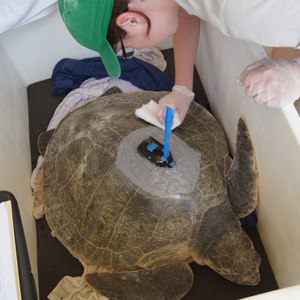TAMUG students join Galveston residents to find and save endangered sea turtles.
Tweet (Galveston, Texas – May 1, 2012) — Kemp’s ridley turtles are native to and primarily found in the Gulf of Mexico and remain the most critically endangered species of sea turtle. In efforts to save these turtles, Texas A&M University at Galveston trained students and volunteer residents of Galveston to locate and identify sea turtle tracks and turtle nests on Galveston beaches.
(Galveston, Texas – May 1, 2012) — Kemp’s ridley turtles are native to and primarily found in the Gulf of Mexico and remain the most critically endangered species of sea turtle. In efforts to save these turtles, Texas A&M University at Galveston trained students and volunteer residents of Galveston to locate and identify sea turtle tracks and turtle nests on Galveston beaches.
National Parks Service Biologist Cynthia Rubio led the volunteers through both classroom and hands-on training; providing general track detection training and background information about ongoing recovery efforts to save the endangered Kemp’s ridley turtle from extinction.
According to Dr. Kimberly Reich, director of the TAMUG Sea Life Facility, the nesting season for the Kemp’s ridley sea turtles began April 1 and volunteers are now in place to cover the 45 miles of Galveston and Surfside beaches six days per week.
The number of nests both in Mexico and the Texas coast continue to increase gradually, in part due to dedicated efforts of volunteer patrollers and protection of turtles both on the nesting beach and in the water. According to the U.S. Fish and Wildlife Service, more than 20,000 nests were documented in Mexico in 2011. Of these nests, 81 percent were along the coastline patrolled at Rancho Nuevo. The USFWS reports that in the United States, 199 nests were recorded in 2011, primarily in Texas.
 Dr. Kimberly Reich, assistant research scientist and director of the Texas A&M Sea Life Facility, leads the organization of patrols for Galveston Island and Surf Side. Walking patrols cover from East End to 61st Street, while volunteers on utility terrain vehicles patrol West End and Surfside beaches. A number of the students working or volunteering at the Sea Life Facility will also be participating in patrols this season.
Dr. Kimberly Reich, assistant research scientist and director of the Texas A&M Sea Life Facility, leads the organization of patrols for Galveston Island and Surf Side. Walking patrols cover from East End to 61st Street, while volunteers on utility terrain vehicles patrol West End and Surfside beaches. A number of the students working or volunteering at the Sea Life Facility will also be participating in patrols this season.
Sarah Horn, a TAMUG student working at the Sea Life Facility and a trained sea patrol staff member is eager to see turtles in their natural habitat.
“Our work in the Sea Life Facility is striving towards getting these turtle back in the wild,” Sarah said. “By doing patrols on the beach and seeing these healthy turtles in the wild, we can be reassured that our conservation efforts will have paid off.”
###